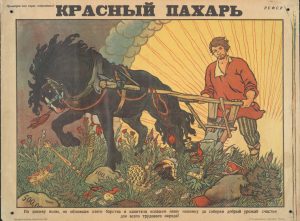“Red Ploughman” (1920 Soviet propaganda poster)
Note: This is the fourth post in what will become an ongoing “Five Questions with” series where students enrolled in the Fall Havighurst Colloquium on Russia in war and revolution pose questions to the guest speakers who speak to the class. Today’s five questions were posed to Dr. Aaron Retish, Associate Professor of History at Wayne State University.
By Emily Oneschuk, Daniel Grober and Meghan Brandabur
Question 1: How did you get involved with Russian Studies? Also, since this class pertains to WWI and the Revolution, what excites you the most about this time period?
I came of age when the Cold War was heating up in the 1980s. I feared war with the Soviet Union but was also fascinated by the country that had been termed the Evil Empire. It also helped that my grandparents and great grandparents emigrated from the Tsarist Empire. I read histories of Russia but it was only in university after taking stimulating courses on Imperial Russian history from David McDonald at the University of Wisconsin and on the Russian Revolution from Chris Read at the University of Warwick that I began to realize my passion for Russian history in general and the Revolution in particular. I was also learning about Russia and the Revolution just as its product, the Soviet Union, collapsed. The Revolution still excites me for its potential to change the course of history, something that everyday citizens of Russia seemed to understand in 1917. The lasting global significance of the revolution affected me, but it was how much peasants, workers, and soldiers (but really peasants) seemed to shape the political world around them that hooked me.
Question 2: Much of your recent work focuses on Russian peasantry during WWI. What are some of the big ideas about this topic that you hope students will take away?
If students come away with the understanding that peasants played an active role in the First World War, then I will be happy. Other than that, my four big ideas about Russia’s peasantry during the First World War are: for villagers the revolution really began in 1914. This is something that Peter Holquist argues for Russia as a whole but it is important to underscore that this was felt by everyday people as well. Second, many peasants felt a patriotic duty to Russia to be active participants in the war effort; third, the war transformed the economy and politics of the village, which prepared peasants for 1917 and the Soviet era; and finally, there was not one homogenous peasant experience. Villages and individual peasants understood and experienced war and revolution differently based on such factors as environment, proximity to urban locations and transportation centers, gender, ethnicity, and social status.
Question 3: How have your studies about Russia during the Great War shaped your own thoughts on the peasant-state relationship between 1914 and 1922? Have they changed or evolved since you have been studying the subject?
My thoughts on the peasant-state relationship change on a near daily basis. Post-colonial studies and the work of James C. Scott informed my thinking on peasant-state relations and on theories of resistance early on in my work. Once I spent time in the archives, though, I started to see that the relationship between peasant populations and the various arms of the state was much more complicated than I had imagined. Indeed, at the local level, representations of power or the manifestation of the state were often made up largely of peasants. In Viatka province, even many of the zemstvo officials were peasants. I have come to appreciate that we need to study the specific local state organs (be it court, land committee, hamlet ispolkom, village soviet, or others.) and their relationships with diverse peasant populations, rather then make a sweeping generalization.
Question 4: When conducting research and writing about Russia, what has surprised you the most?
Every document in the archive has a surprise, which makes research so much fun. It might be a small detail like a clue to an individual otherwise lost to history or something fun like a stamp of a rake and sickle (rather than a hammer and sickle) that I saw on local executive committee reports in 1918. I had a few moments of pure surprise for my first book. When I found evidence that an officer who was supposed to be leading grain requisitioning instead began to rob banks and overthrow Soviet power across an area about the size of Indiana, that was pretty surprising. When I found hundreds of documents on peasants contesting the land redistribution that was also exciting. But really it is finding clues from archival documents that make up a larger historical story that never fails to surprise me.
Question 5: When writing Russia’s Peasants in Revolution and War was there a chapter you would have liked to add but did not due to a lack of time or source material?
Great question! Yes. I wanted to add a section on revolutionary tribunals but it didn’t fit. In fact, the section was based on a paper that I gave at the Havighurst Center’s Young Scholars Conference in 2001. All things work out in the end. Tribunals were part of the revolutionary judicial system, which is the subject of my current book. Thinking about my book more, I also wish that I had included more on the violence of the war as well as the popular frustration with the Soviets and sheer exhaustion from the Revolution by 1921.
Emily Oneschuk is a junior majoring in Mechanical Engineering and REEES. Meghan Brandabur is a sophomore majoring in REEES and Strategic Communication. Daniel Grober is a senior majoring in Political Science.

